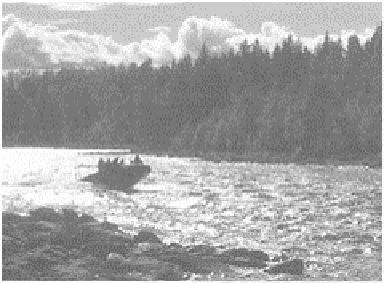Geography Reference
In-Depth Information
Plate 7.3:
Northern Sweden. Wild
rivers may provide options for
jetboating, but the noise of such river
use may disturb other recreationists.
INSIGHT: Peripheral areas, wilderness and global environmental change
Although human impacts have long been recognized as a threat to the integrity of
wilderness area they have usually been seen in terms of immediate or relatively short-
term impacts in the form of erosion, changed species behaviour, or reduction of
naturalness. Arguably, a far more serious long-term impact that is also wider in scale is
that of global environmental change (Gössling and Hall 2005; Hall and Higham 2005).
Many alpine environments have already begun to be affected by climate change
(Beniston 2003). For example, since 1850 the glaciers of the European Alps have lost
about 30 to 40 per cent of their surface area and about half of their volume (Haeberli and
New Zealand 1998). Glaciers in the Southern Alps of New Zealand have lost 25 per cent
of their area over the last 100 years (Chinn 1996). Glacial retreat is also prevalent in the
US Pacific Northwest (Benistion 2003) and the higher elevations of the tropics, with Mt
kenya and Mt kilimanjaro having lost over 60 per cent of their and cover during the
twentieth century (Hastenrath and Greischar 1997).
Climate change is regarded as being potentially extremely damaging to Southern
Hemisphere ski tourism operations (Hall and Higham 2005). Whetton et al. (1996) write
of the total loss of the Australian skiing industry by 2020 in a worst case scenario.
Similarly, Perry and Illgner (2000) argue that skiing in the Drakensberg Mountains of
South Africa will cease to be viable by 2050 if the current rate of temperature increase
continues.
In their study of the Swiss ski industry Abegg and Froesch (1994) demonstrated that if
temperatures were to rise by about 2-3°C by the year 2050, the low to medium elevation
resorts located below 1200-1500 m above sea level would be substantially affected.
Warmer winters bringless snow at these elevations, and the probability of snow lying on
the ground at peak vacation periods (Christmas, February and Easter) would be reduced
(Beniston 2003). Using a general rule for the viability of the ski season in Europe of a
continuous snow cover of over 30 cm depth for cent US higher US and cent century at





